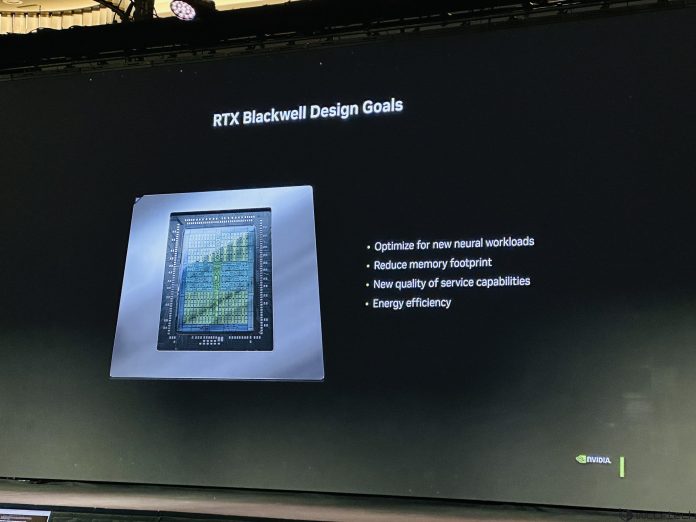At CES 2025, NVIDIA offered us a deep-dive of its next-gen Blackwell GPU architecture for RTX 50 gaming GPUs and how it improves upon Ada.
NVIDIA GeForce RTX 50 “Blackwell” GPU Architecture Dissected: More AI-Focused Cores, More Throughput, DLSS & Reflex Upgrades, Coprocessor and A Ton More
The NVIDIA Blackwell or RTX Blackwell architecture is designed specifically for gamers and content creators. This architecture will be offered on the RTX 50 graphics cards first which launch later this month.
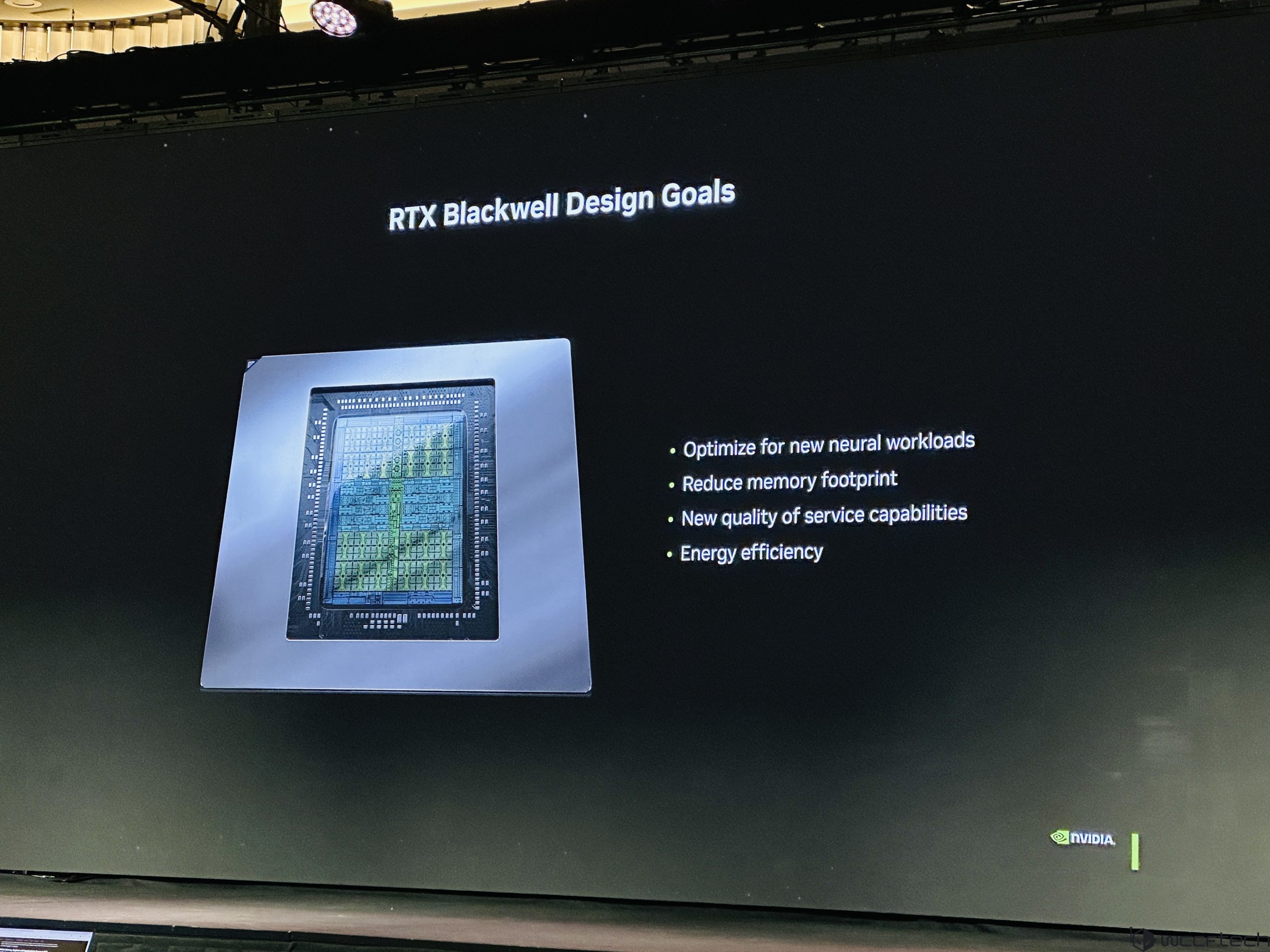
NVIDIA RTX Blackwell Architecture Deep-Dive
What we have known so far about the NVIDIA RTX Blackwell Gaming GPUs is that they are based on TSMC’s 4nm process node, feature up to 92 Billion transistors with 4000 AI TOPS, 380 RT TFLOPs, a 125 TFLOPS of FP32 compute, the fastest GDDR7 memory interface with up to 1.8 TB/s bandwidth and come with a brand new Founders Edition design.
With Blackwell, NVIDIA had a few design goals in mind to accelerate the graphical capabilities for the next generation of gaming. The architecture was to be designed and optimized around new neural capabilities and workloads. It aims to reduce the overall memory footprint, it also focuses vastly on energy efficiency, and all the while adding new quality of service capabilities.
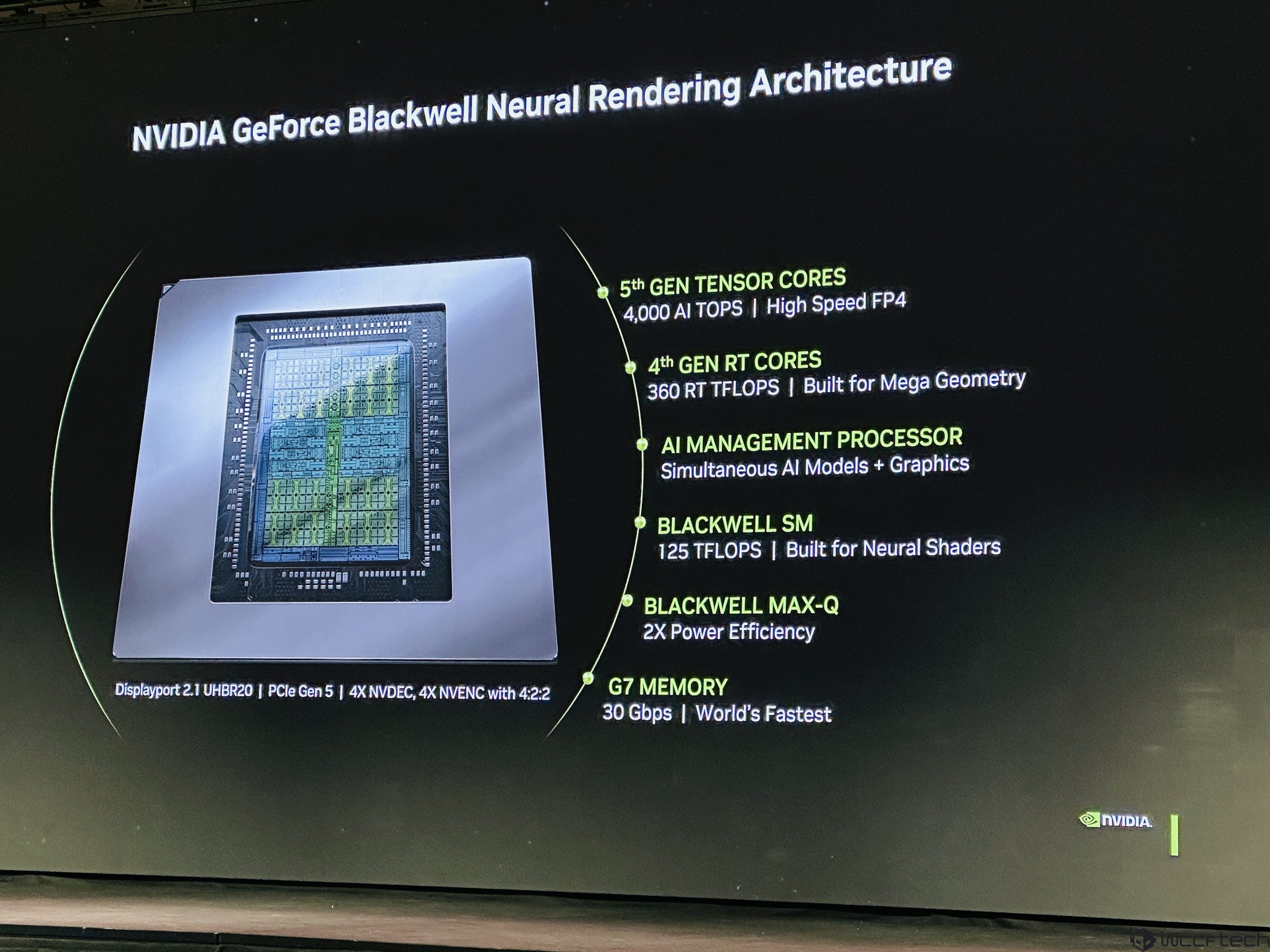
So Blackwell had to introduce a lot of changes and the main ones include the addition of 5th Gen Tensor Cores, offering high-speed FP4, compute and up to 4000 AI TOPS of performance, 4th Gen RT (Ray Tracing) cores with up to 360 RT TFLOPs and designed for Mega Geometry, a next-gen AI Management Processor which enables Simultaneous AI models and graphics workloads to be executed, a brand new Blackwell SM with 125 TFLOPS of peak FP32 compute and the addition of GDDR7 memory which offers the world’s fastest memory speeds of up to 30 Gbps (on the RTX 5080).
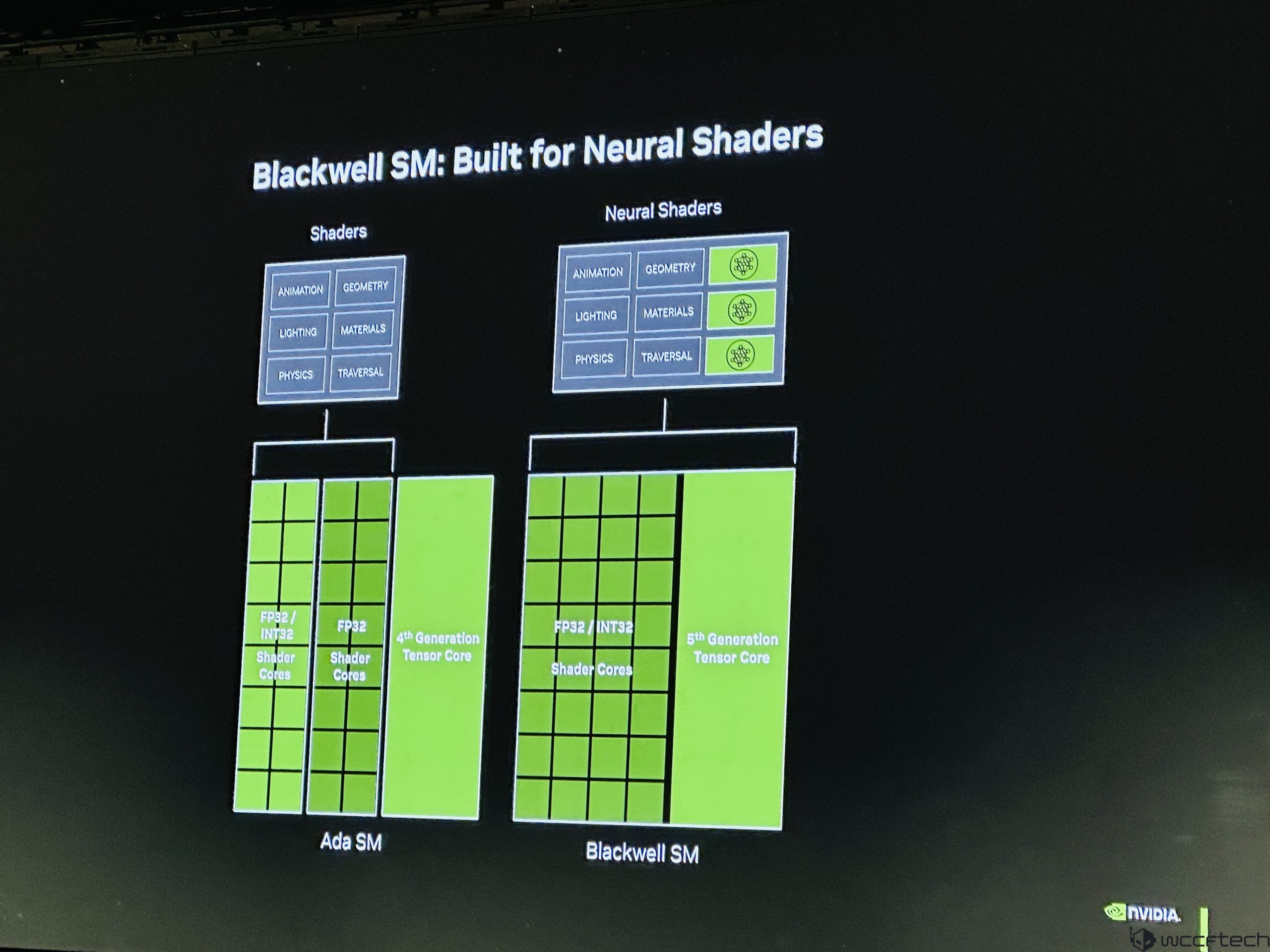
Other notable additions to the RTX Blackwell GPU architecture include DisplayPort 2.1 (UHBR20), PCIe Gen5 support, and 4K NVDEC/NVENC with 4:2:2 colors.
Diving into the Blackwell SM, we first compare it with the Ada SM, which was mostly optimized for traditional shaders, & most of its Tensor cores were used either for DLSS or content creation apps. Ada also partitioned the FP32 cores into two blocks, one that could purely execute FP32 and one that could execute both FP32 & INT32 formats. With Blackwell, NVIDIA has doubled its INT32 GPU throughput which can help accelerate workloads such as Work Graphs and Shader Execution, and 5th Gen Tensor Cores also offer the aforementioned doubled throughput.
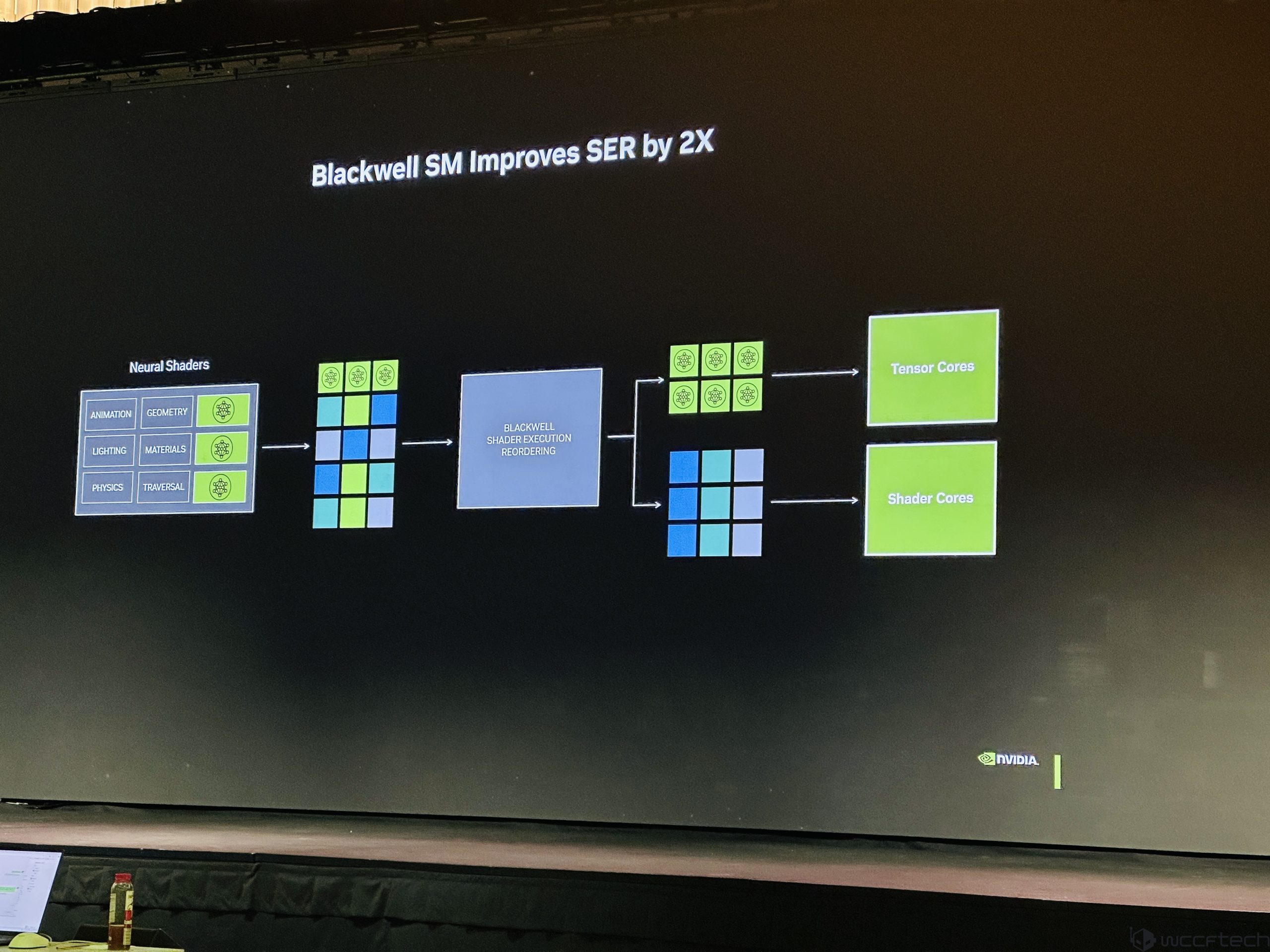
Other microarchitectural changes allow multiple workloads to be executed efficiently. Blackwell also improves SER (Shader Execution Reordering) by 2x by reordering the neural models and the standard shading models and putting the same work together in an organized fashion. These models are then passed through tensor cores (if ML models) or shared cores (if shading models) for final execution.
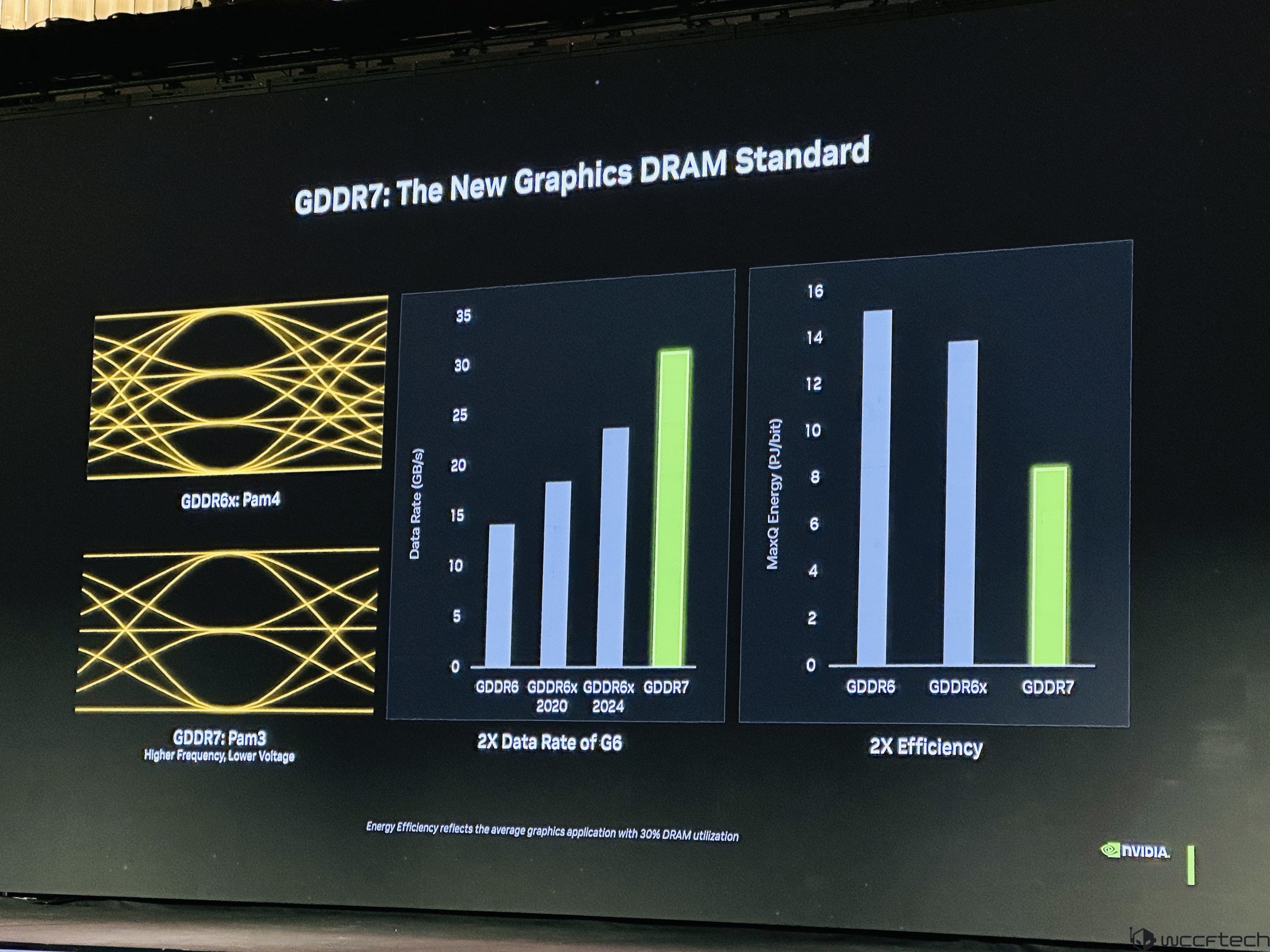
GDDR7 also brings a much-needed upgrade over GDDR6/X memory, offering twice the bandwidth and data rate of G6 memory with higher frequency and lower wattage. GDDR7 also supports PAM4 signaling and the PCB materials used on RTX 50 GPUs are top-of-the-line from an engineering point of view. This is the first full-fledged architecture for desktop PCs to utilize both GDDR7 and PCIe 5.0 materials in full conjunction. The new memory interface also offers twice the efficiency of GDDR6 in terms of PJ/bit. This will be very useful in mobility “Max-Q” designs where efficiency matters the most.
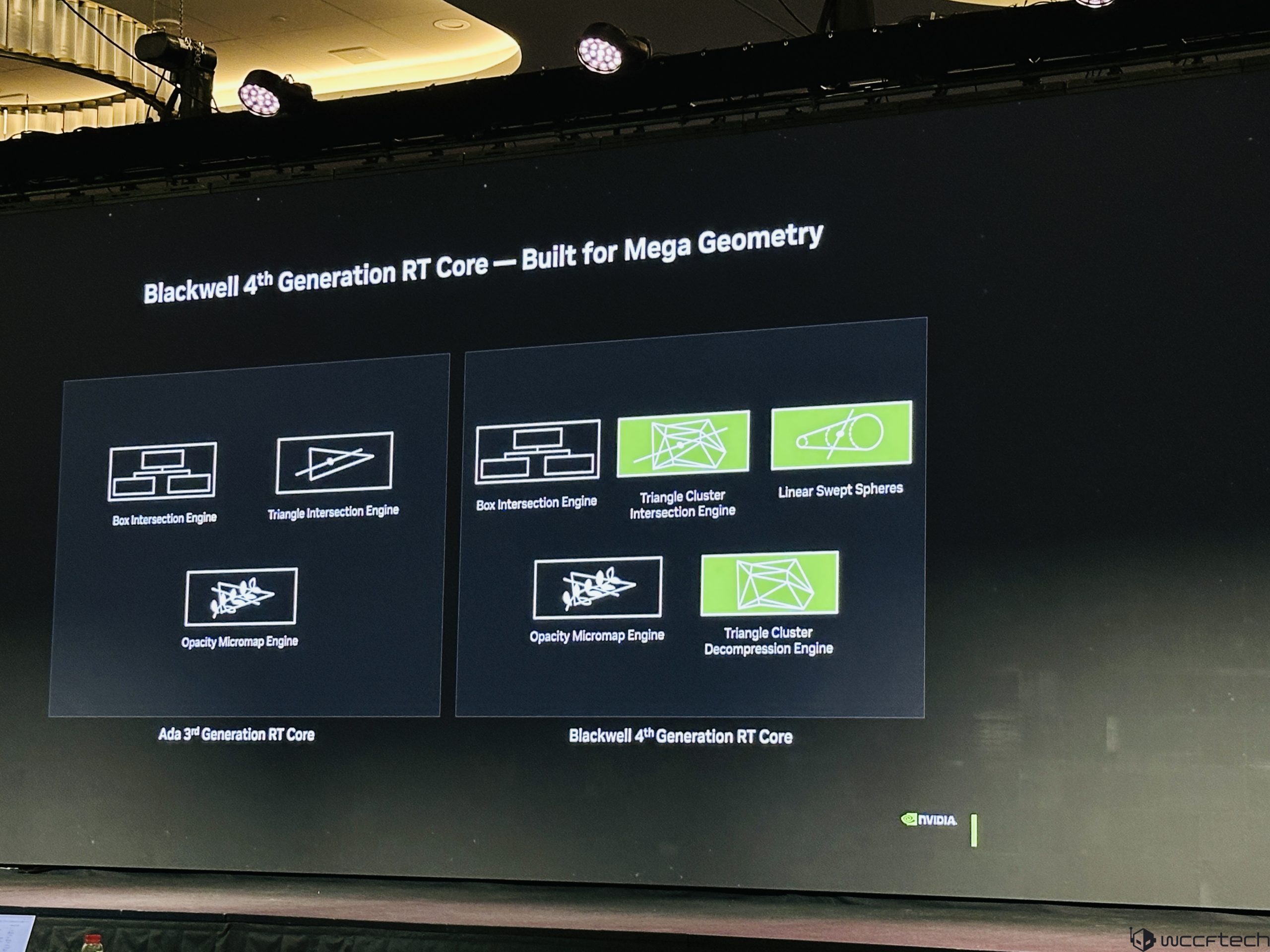
Moving over to the Ray Tracing enhancements, the 4th Gen RT Cores introduce various new capabilities, such as a Triangle Cluster Intersection Engine which replaces the previous Triangle Intersection Engine which is optimized for Mega Geometry and can handle clusters of Mega Geometry and standard geometry much more efficiently.
The Mega Geometry engine also has a new Triangle Cluster Compression format which can be decompressed using Blackwell’s on-chip engine. Lastly, there’s the new Linerar Swept Spheres block which accelerates RTX Hair and Fur rendering. To sum things up, the new RT cores bring an 8x ray triangle intersection rate while reducing the memory footprint to 0.75x.

The FP4 format introduced on Blackwell’s 5th Gen Tensor Cores will offer up to 32x throughput versus the Pascal generation and 2x versus the Ada generation of GPUs. These new cores will be taking full advantage of Neural Shading and Rendering techniques featured in next-gen AAA titles.
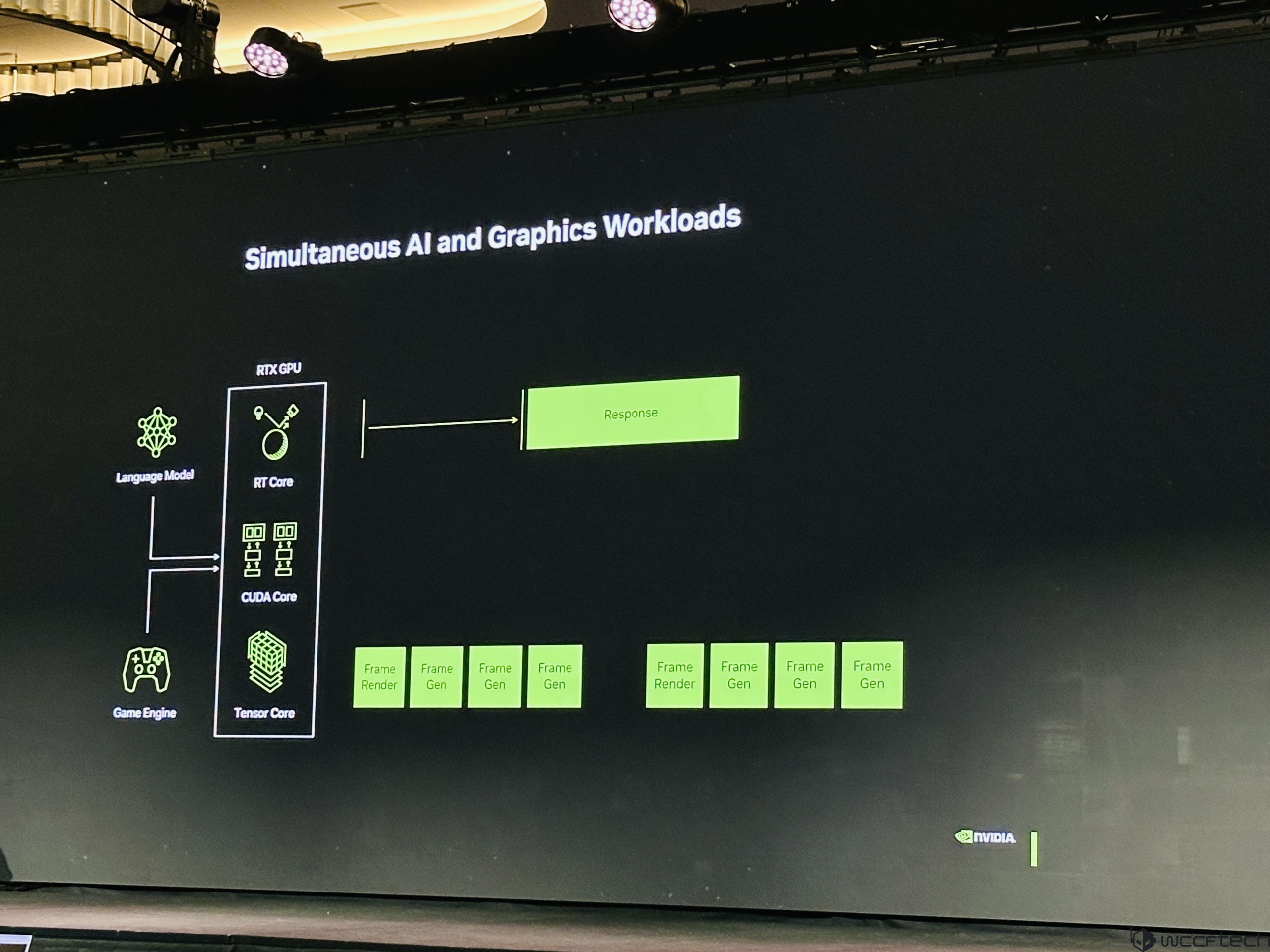
This also leads us to the next topic, which is about Blackwell’s scheduling and how it processes various workloads. In Blackwell, NVIDIA is introducing a new programmable Coprocessor known as Amp which sits at the front of the GPU, and interacts differently with the different cores on the GPU while understanding what’s running on them, what’s being done on them, and scheduling precisely the specific workload for the right core.

NVIDIA also talked about Blackwell’s new Power Gating modes. In Blackwell, the entire clock tree can be disabled even while the GPU is active. So, if the memory system or portions of the memory system are idle, power savings can be achieved this way.
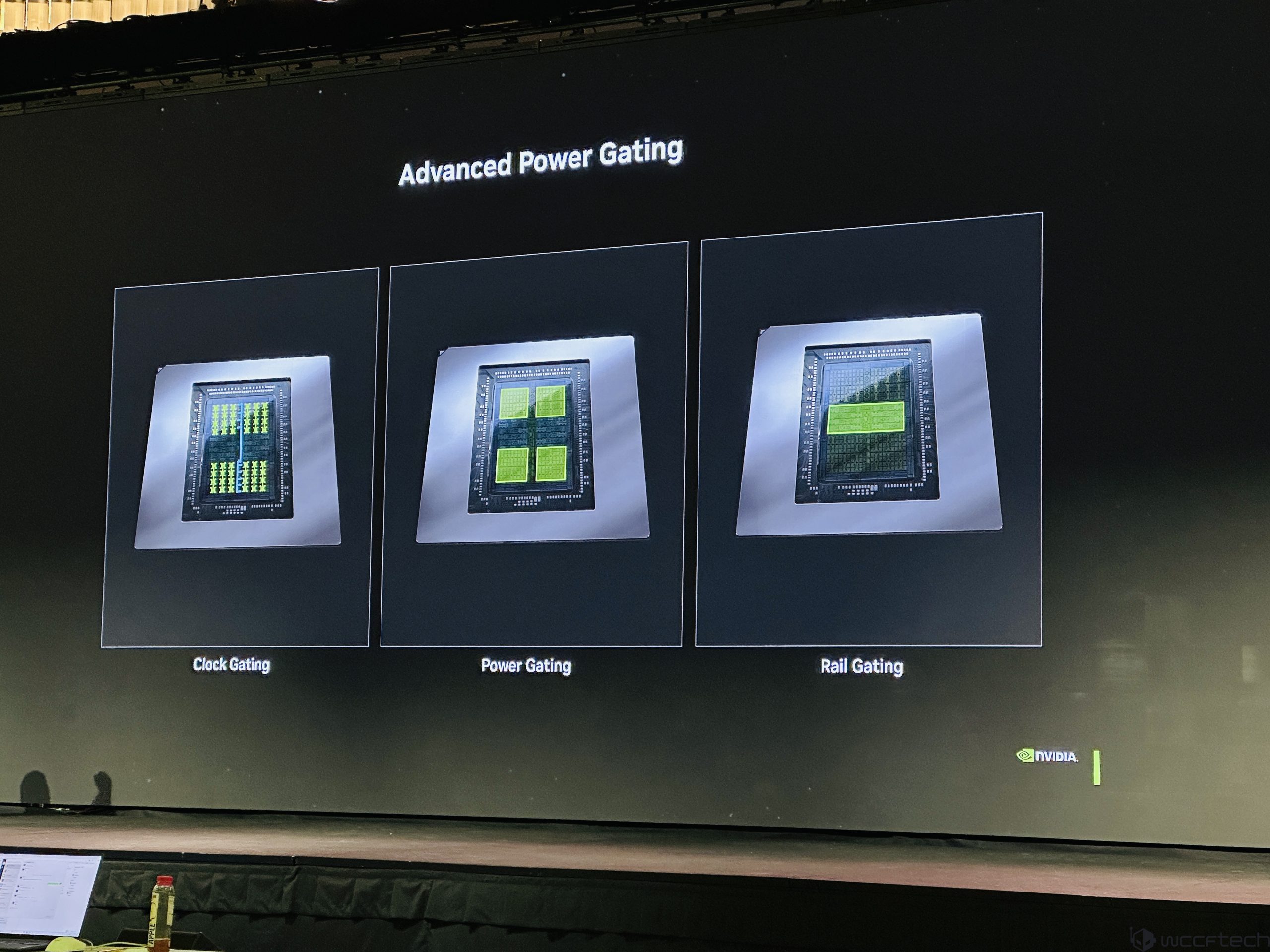
Another way to save power is to disable logic and SRAM when entire engines are idle. Blackwell also introduces a secondary rail that separates the core and the memory system which runs them at different voltages and, for different workloads, captures more performance within a power budget. It also allows a 15x reduction in the time it takes from the rail gate to the core. The new rail gate system is particularly useful in laptops as it reduces leakage by a major margin.
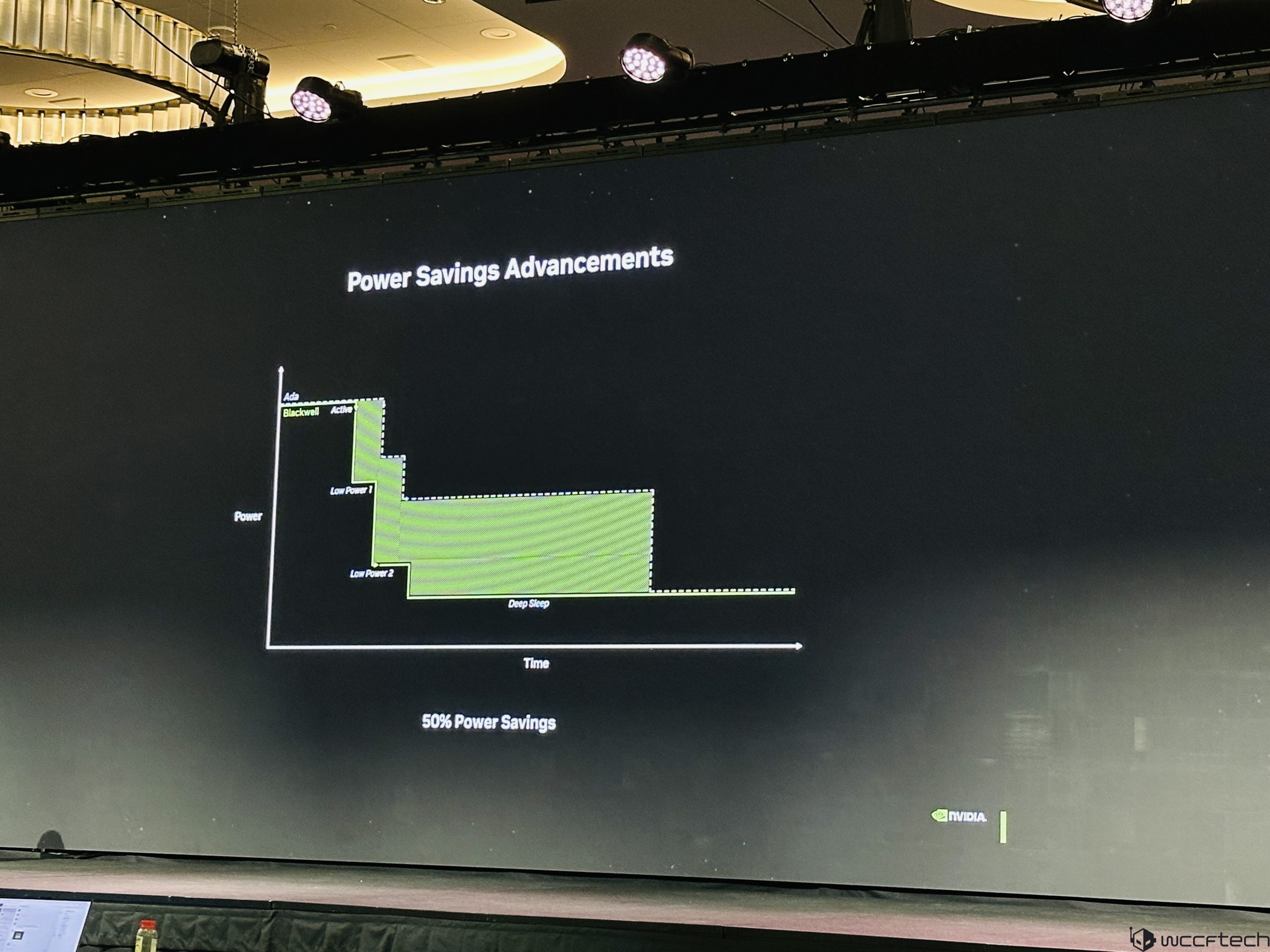
A new aspect of Blackwell is also its accelerated frequency switching capability, which improves clock responsiveness by 1000x. For example, a workload such as physics which doesn’t utilize the full width of the GPU can switch to a higher frequency, while a tensor core workload which can use the full width of the GPU can move to a lower frequency. But when the CPU hasn’t fed the GPU with any work, Blackwell can drop frequency fast and this is done because Blackwell can switch back to a faster frequency faster.
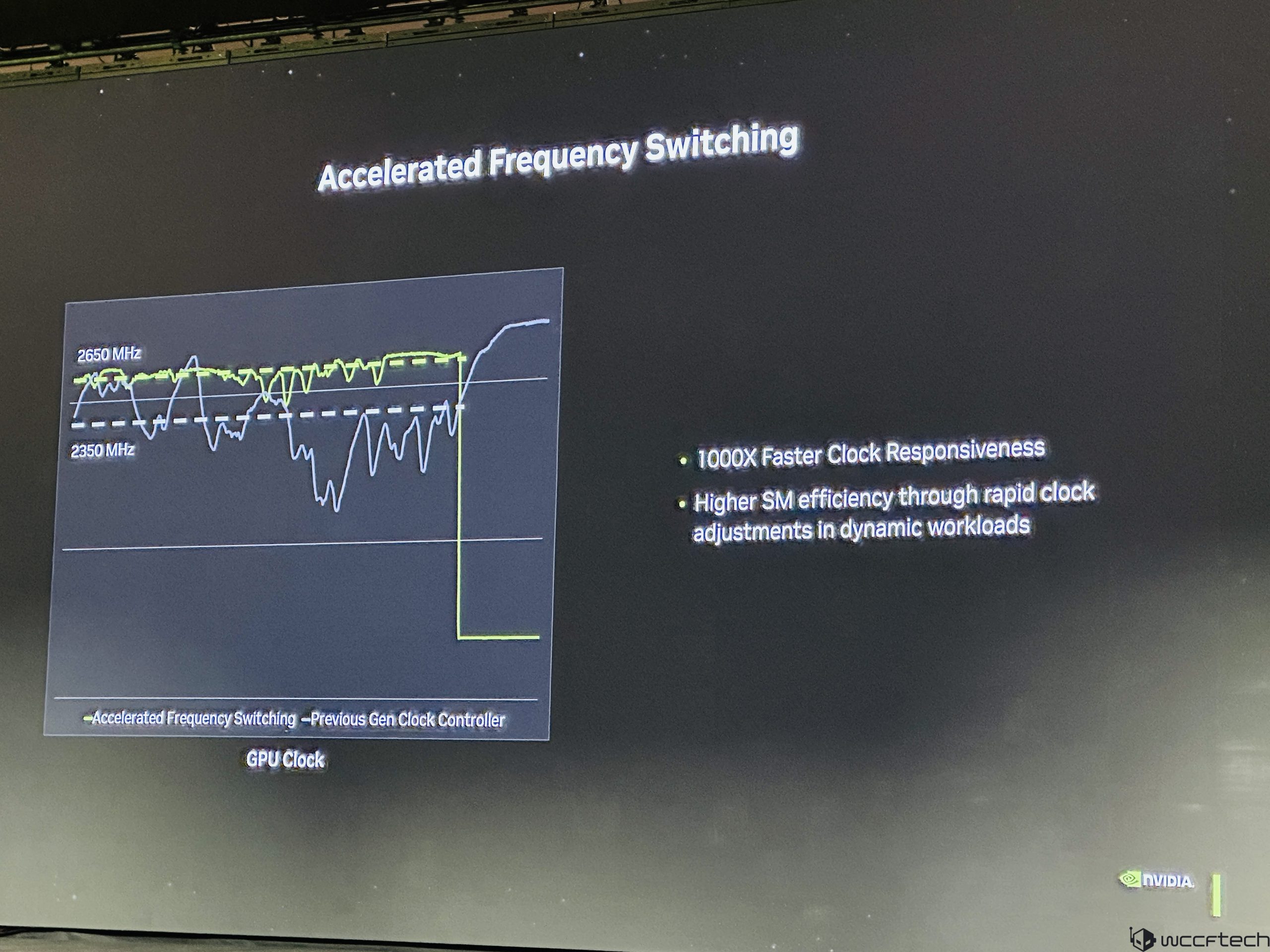
In terms of clock frequency uplift, Blackwell achieves a 300 MHz higher frequency in active state versus Ada GPUs.
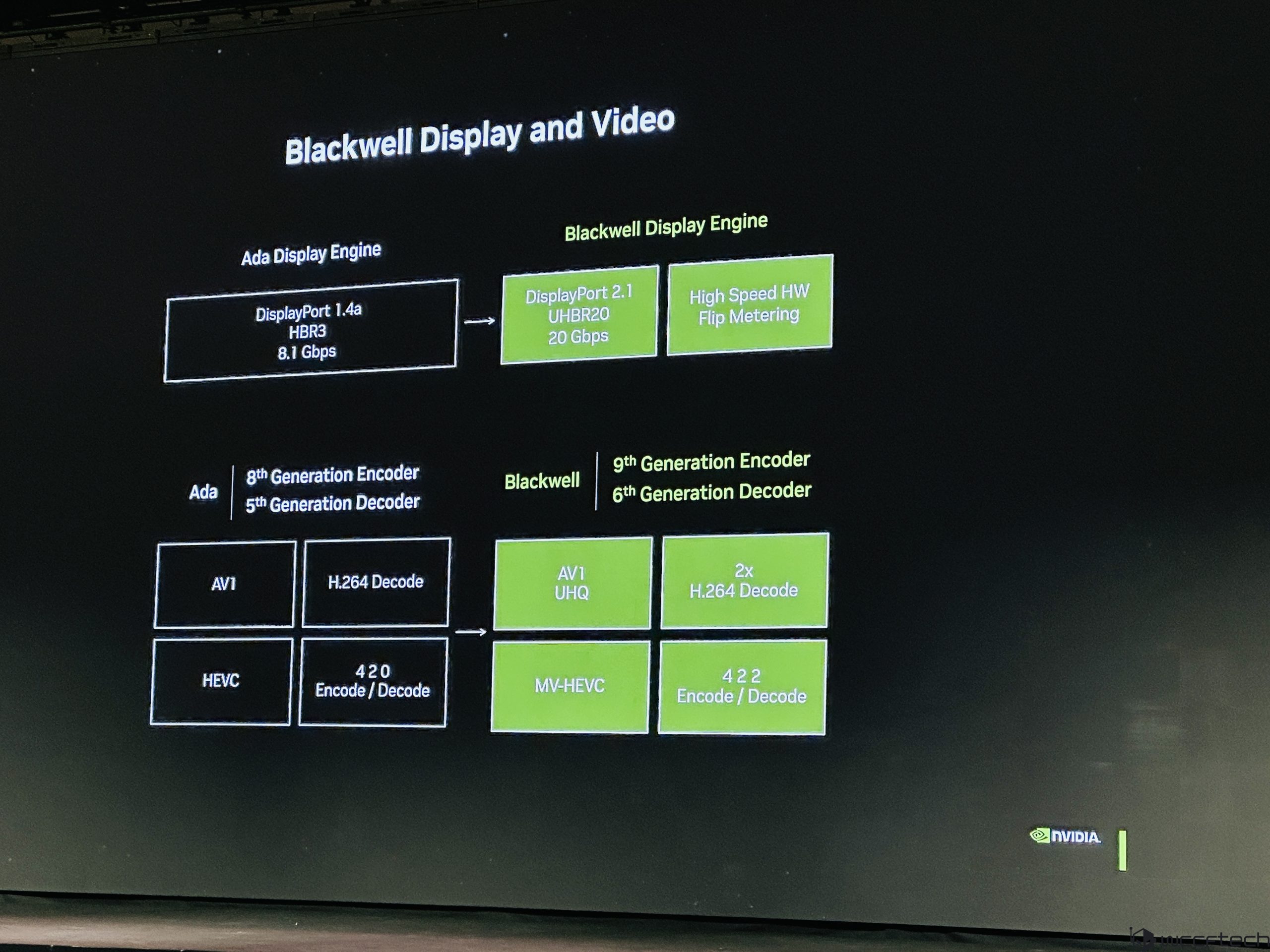
Lastly, we have Blackwell’s Display & Video capabilities. New support on Blackwell includes support for DisplayPort 2.1b (UHBR20) with High-Speed hardware flip metering which improves the pace of frames using DLSS 4. There’s also the 9th Gen Encoder and 6th Gen Decoder, offering AV1 UHQ & 2x H.264 Decode capabilities, while MV-HEVC and 4.2.2 Encode/Decode are also included in the RTX Blackwell Video engine block.
NVIDIA DLSS 4 – Continuing The Deep Learning Innovations
Since the advent of DLSS back in 2018, the technology has been improving continuously. The DLSS model is being trained on a supercomputer housed within the NVIDIA HQ which is running 24/7 & uses the latest and greatest of their GPUs for the past 6 years. The last major iteration of DLSS was DLSS 3.5, which introduced ray reconstruction. This new feature was part of the failure process in which the model detects various issues such as blurriness, ghosting, and flickering.
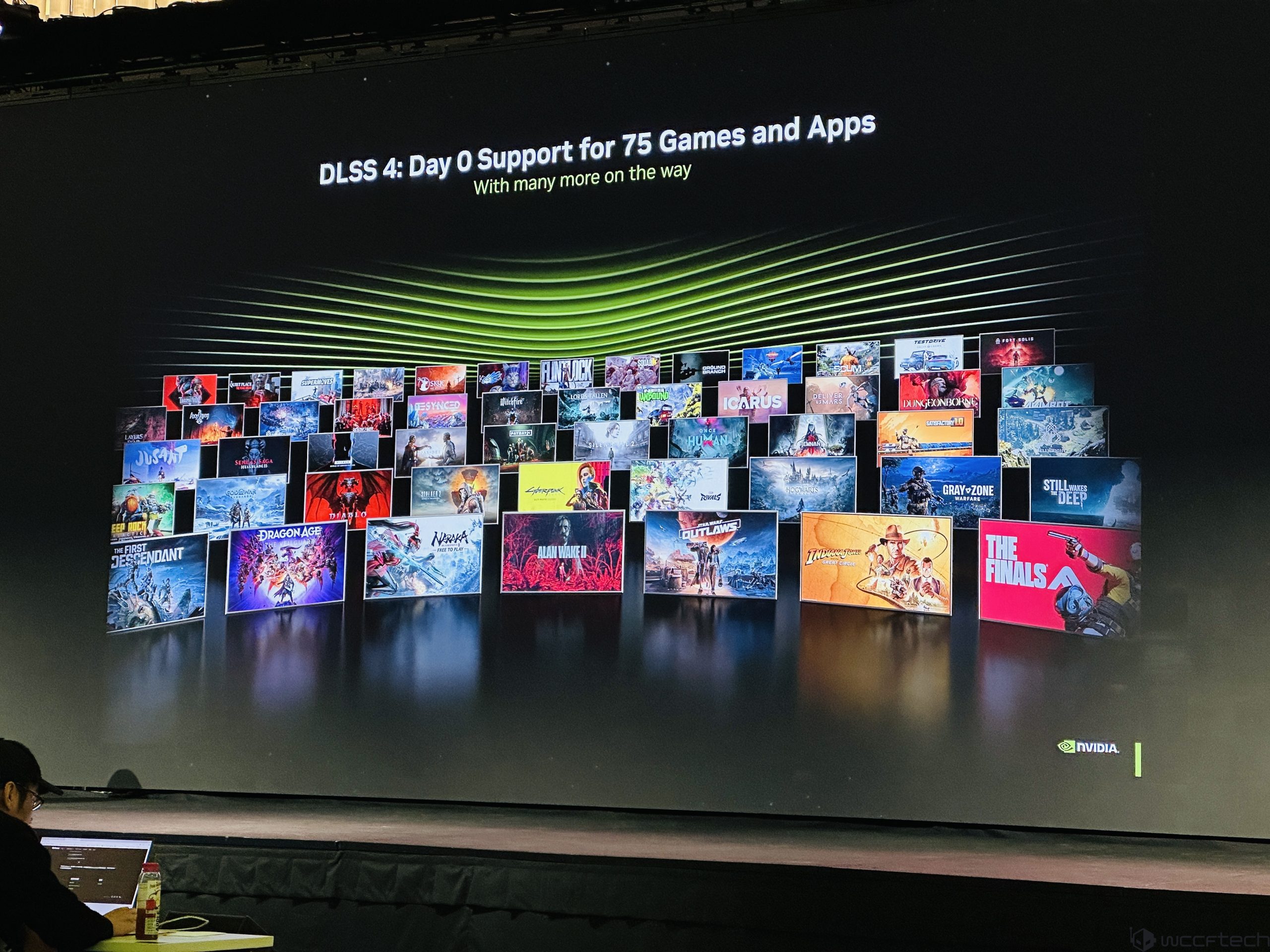
NVIDIA’s in-house team of engineers then try to figure out what went wrong in the model and why the image wasn’t created as intended. New approaches are defined to augment the model set which is retrained and tested across 100s of games to achieve the desired image quality and these result in upgraded versions of DLSS, with the latest one now being DLSS 4, which improves upon all aspects of the Super Sampling technology.
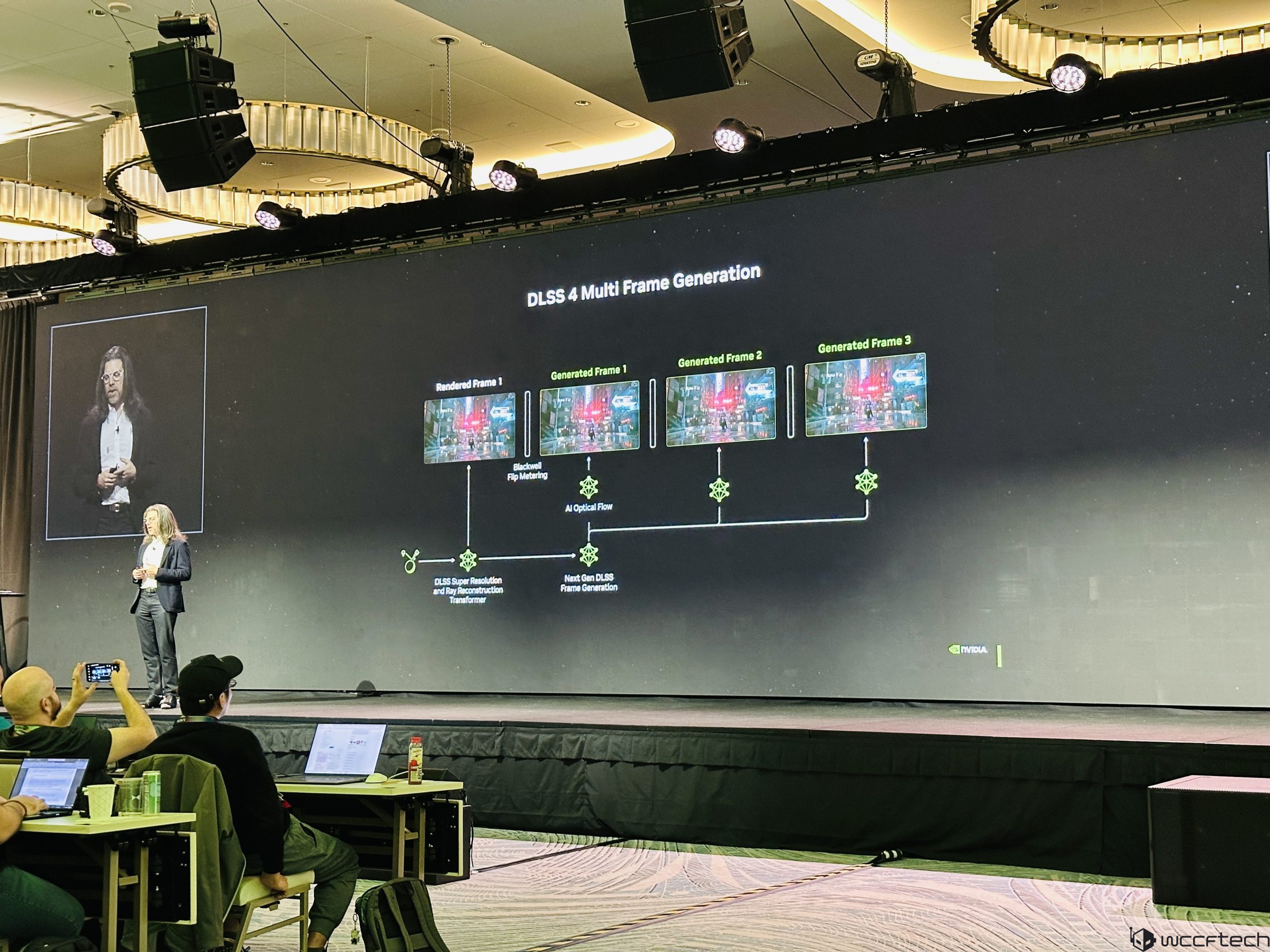
With DLSS 4, NVIDIA is transitioning to a completely new neural architecture model from 2020s DLSS 2. The main change is the new transformer engine which can be trained across multiple data sets while being computationally efficient, offering 2x the parameter size and 4x the compute horsepower.
DLSS 4 also adds the new MFG mode or Multi-Frame Generation which, instead of running two models per frame, runs five models per frame with super-resolution and ray reconstruction. This leads to 15 out of 16 pixels or frames being generated by AI, all the while improving the image quality.
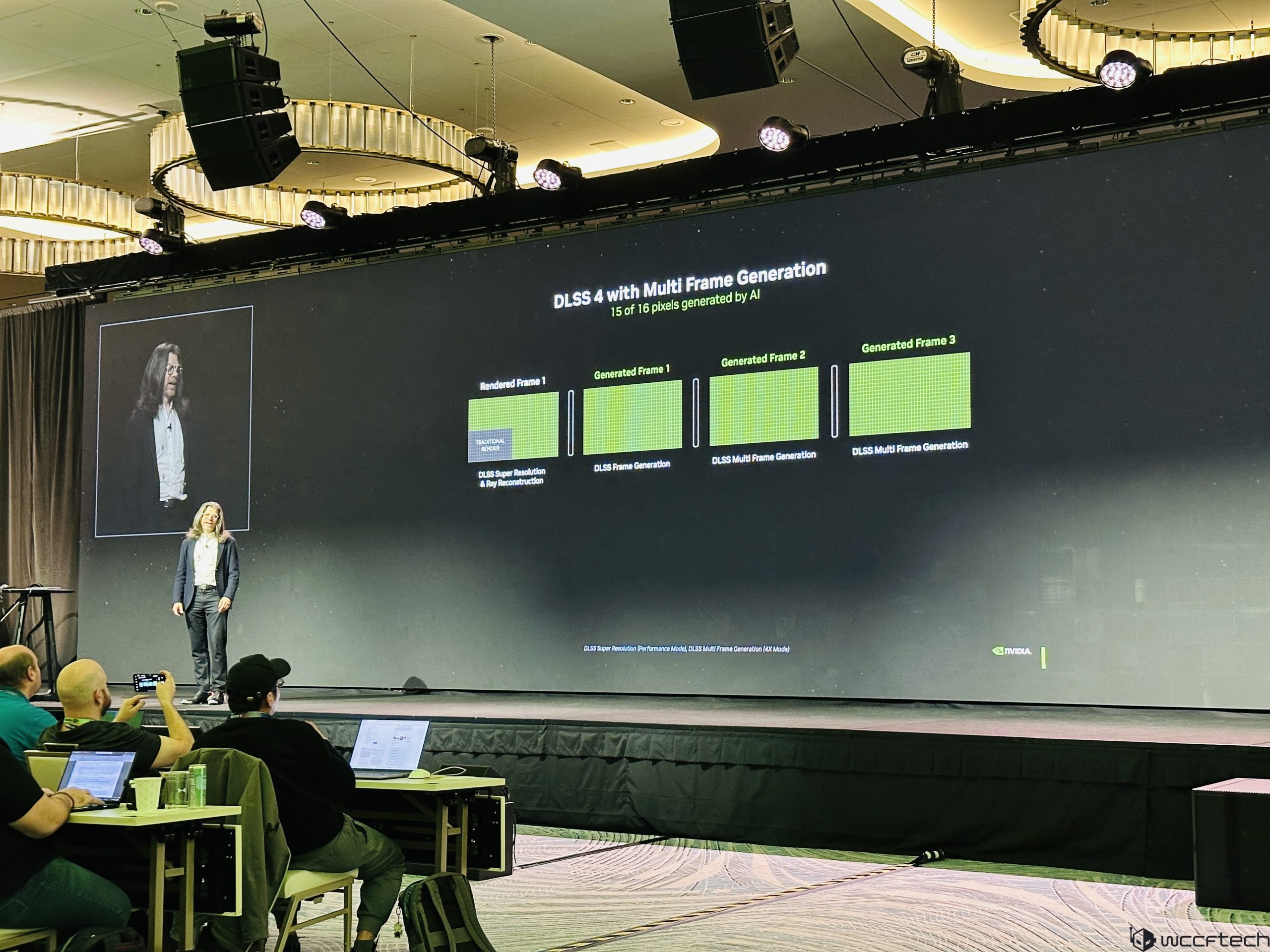
NVIDIA also dives a bit into why they only thought of doing multi-frame frame-gen with Blackwell and there were two reasons, one was that DLSS’s image quality was not that great to begin with and needed more training time, while the second was the time it takes to generate these new frames could result in frame pacing and artifacting issues.
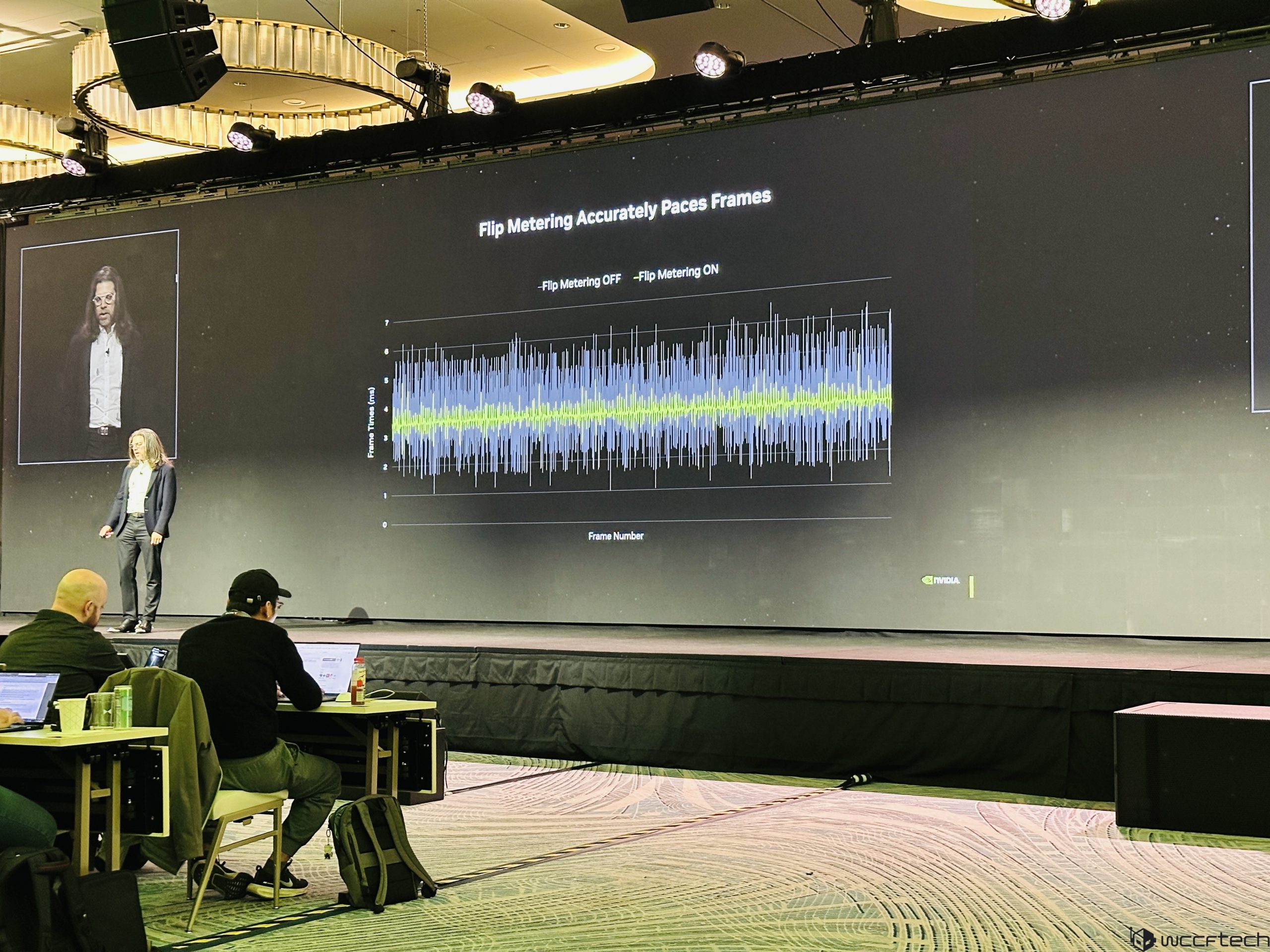
So, as the DLSS model was trained, the image quality became much better, which is fairly noticeable in recent DLSS 3 and DLSS 3.5 titles, while for frame pacing, NVIDIA’s flip metering system is the solution that displays frame and this has been upgraded, and it can now reduce the frame variability by 5-10x, leading to similar or better latency versus last-gen DLSS solutions even when MFG is enabled.
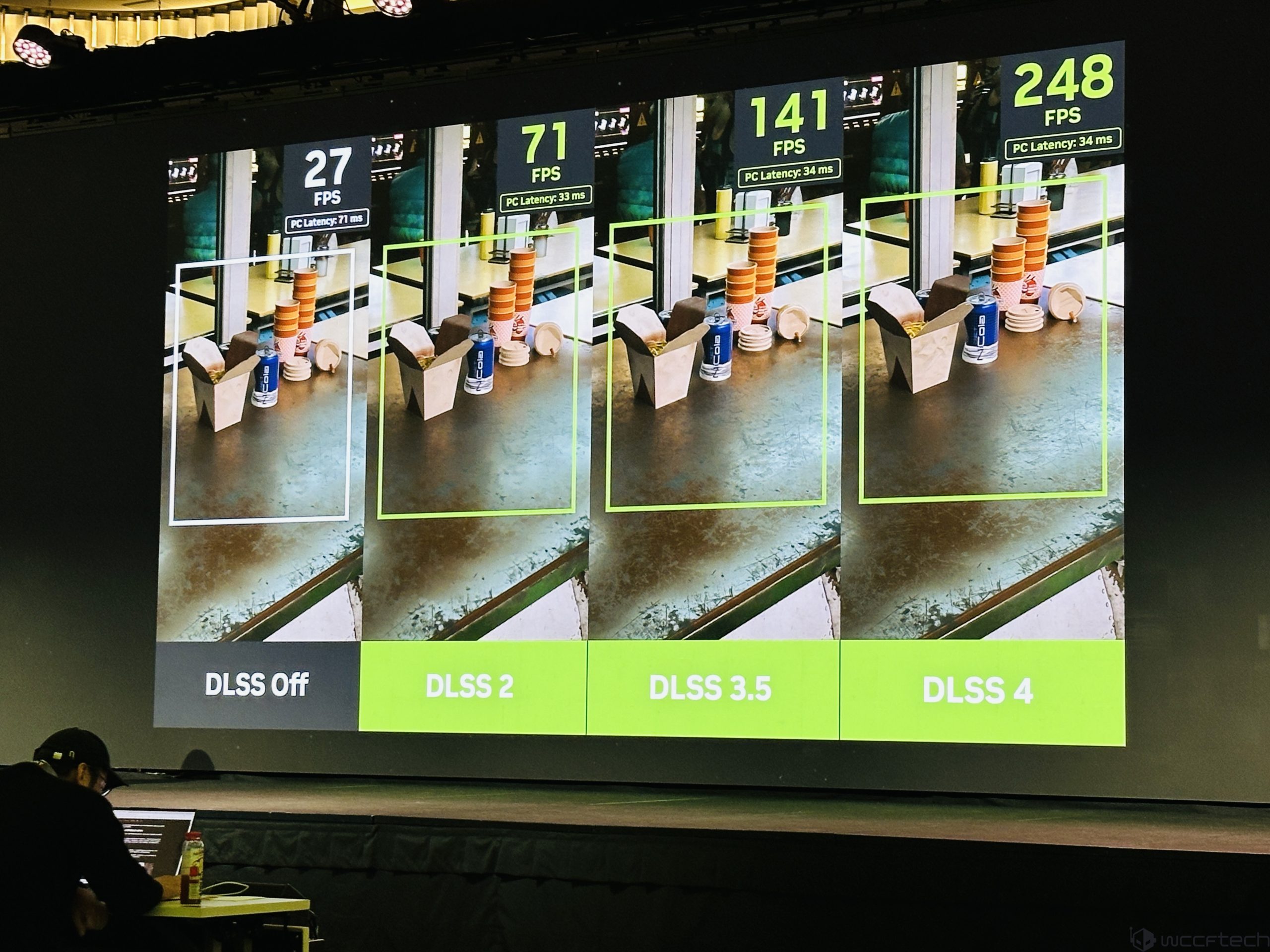
Best of all, while MFG will be limited to RTX 50 and Frame Generation will be limited to the RTX 40 and RTX 50 series, the image quality enhancements and Reflex 2 highlights will apply to all RTX GPUs as we reported here, so all RTX GPU owners are in for a small treat even if they don’t own the latest and greatest hardware.
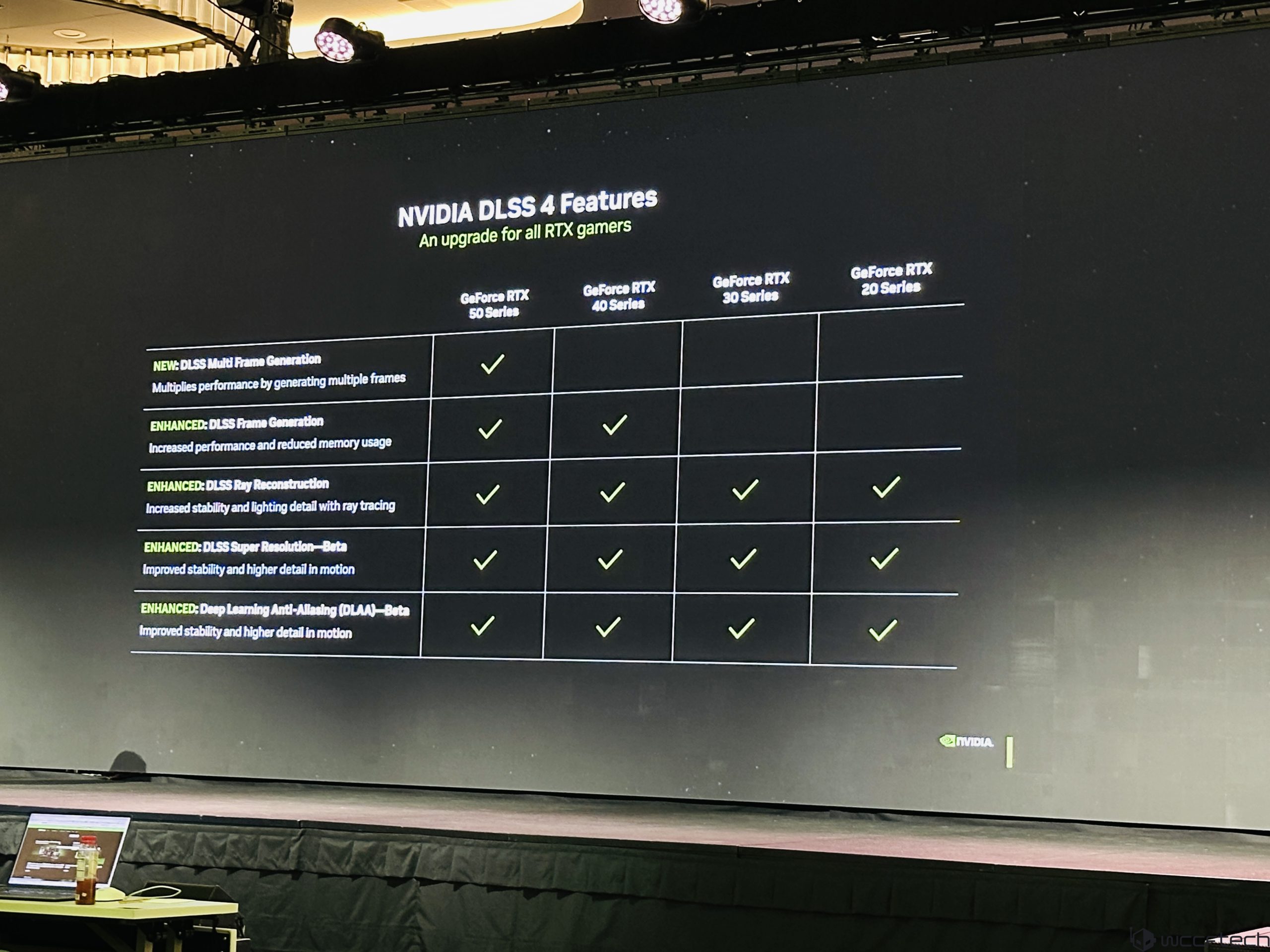
Unlike previous generations of DLSS, DLSS 4 will come with Day-0 support for a total of 75 games and apps, the largest library of DLSS-enabled titles on the first day and more are on the way. To be clear, NVIDIA confirmed that developers will be able to leverage DLSS 4 quite easily if they have already integrated DLSS 3 or DLSS 3.5 within the engines.

NVIDIA will also integrate the option to enable DLSS 4 for non-DLSS-4 titles such as those with DLSS 3 support within its NVIDIA App. You can select between the older CNN mode, which will be a little bit faster but with lower image quality, and choose between various frame generation modes such as 2x, 3x, and up to 4x. Users can also select between resolution override modes such as DLAA if they prefer higher image fidelity or go with DLSS Ultra-Perf, which enables faster performance on RTX GPUs.
Another feature that goes hand in hand with the new DLSS 4 technology is Reflex 2, which is designed to decrease latency and improve responsiveness in games, especially eSports titles. Reflex 2 introduces a new technology called Frame Warp which improves system responsiveness by 75%.
How NVIDIA achieves this is by sampling the mouse position right before the frame is rendered, and the camera is updated based on the user input and then warping the scene to a new position right before the frame is displayed. Reflex 2 will be natively coming to The Finals and Valorant. All RTX GPUs will support Reflex 2.
NVIDIA RTX AI For Gamers: Moving From Programmable Shaders To Neural Shaders
As we stated at the start of this deep dive, the RTX Blackwell architecture is designed with AI in mind and one of the major shifts that NVIDIA is making is to access next-gen Neural Shading technologies. The company has already announced how it’s cooperating with Microsoft to leverage DirectX’s Neural Rendering capabilities that will fully unleash the tensor core prowess of RTX 50 GPUs.
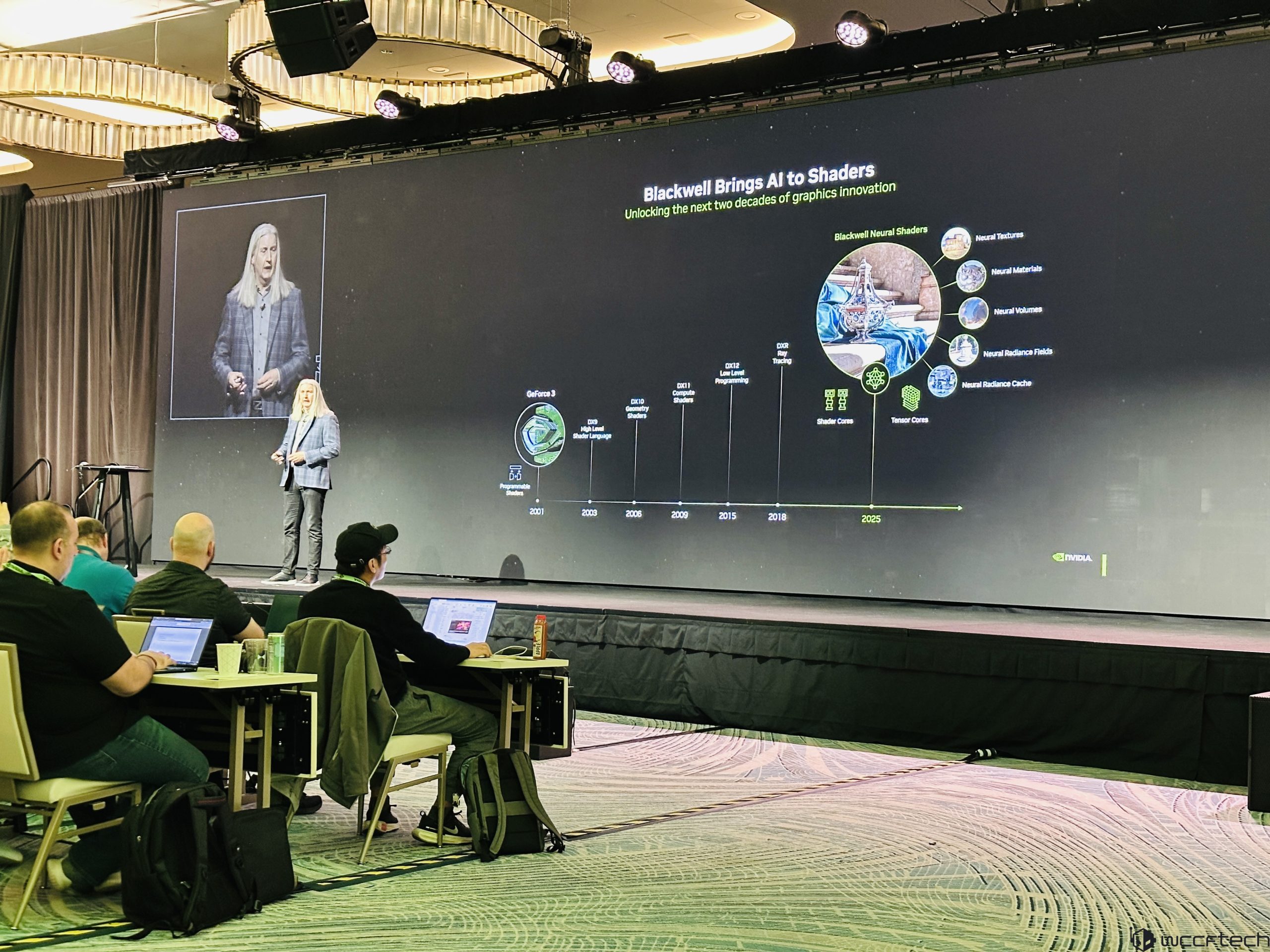
With Blackwell’s Neural Shaders, NVIDIA will harness various means of doing graphics, such as Neural Textures, Neural Materials, Nerual Volumes, Neural Radiance Fields, Neural Radiance Cache, and Neural Compression techniques to help with efficiency and optimization while adding in more performance by leveraging tensor cores.
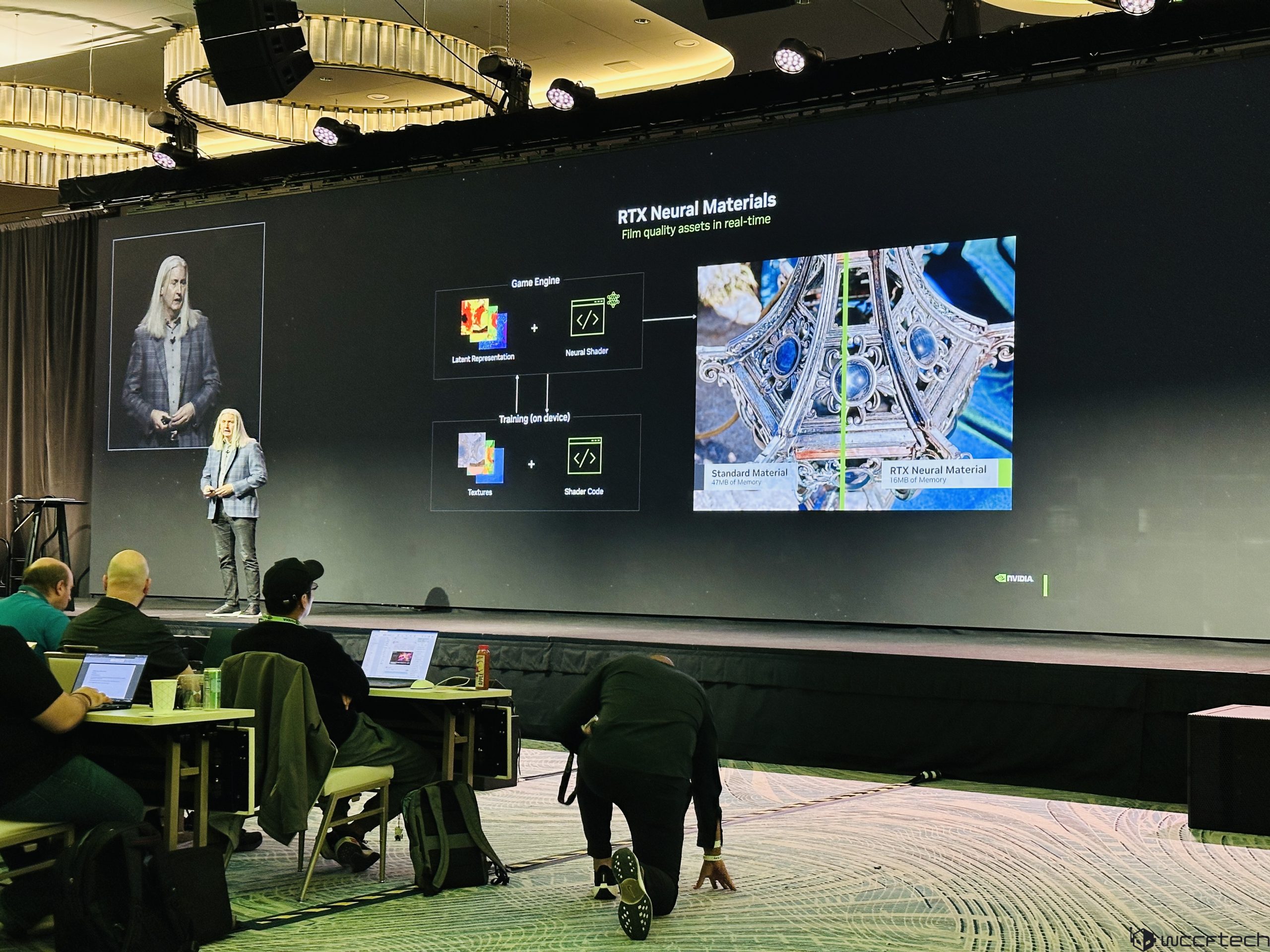
The aim is to replace some or entire parts of the traditional graphics pipeline which has mostly relied on programmable shaders for a while now.
With traditional materials in a real-time scene, it’s usually a few dozen lines of code to several thousand for film rendering, so to faithfully represent the same data, neural materials take the same code and take assembly collective of layers that are associated with a material and lay it out in a neural space (neural recompressed texture 7:1) & then a very small neural network with a few layers that are executed for each pixel on the screen that is using that material. In a demo shown by NVIDIA, Standard Materials take up 47 megs of memory while Neural materials take up just 16 megs of memory, so that’s a factor of 3x.
Next is RTX Neural Radiance Cache for path trace, indirect lighting, and faster performance. NRC is training in real-time using the GPU to create a model on the fly. It collects the transport of light through the scene and caches it geo-spatially, so that you can have virtually unlimited bounces of light throughout the scene of light being transported around and be able to have that in the cache so that you can have one lookup in the cache and represent an unlimited number of bounces on the scene.
One area where Neural Shaders shine is in materials such as skin and, for that, NVIDIA is adding a new feature called RTX Skin. For this purpose, NVIDIA has collaborated with Unreal Technology & Disney, the subsurface scattering algorithm into the real-time realm for path tracing. The demo to showcase RTX Skin was Half-Life 2 Remix, where the bricks are missing indirect lighting by default but enabling NRC brings a lot more detail to the scene. The same can be seen in a Zombie, which looks much more vibrant and shadows are displayed more realistically.
Another feature is RTX Neural Faces, which combine Generative AI Faces with photorealistic characteristics that are trained at different angles, and different lighting conditions and display different emotions too. These can be used to enhance NPCs within games.
Even Ray Tracing hair and fur is discussed with the traditional methods being very expensive, since a character with individual strands may have 6 million strands, which requires a lot of horsepower. In Blackwell’s RTX architecture, this new approach requires fewer polygons and fewer ray-traced spheres, leading to 3x less data to compute and requires less VRAM while offering higher FPS.
Blackwell also introduces a new groundbreaking technology called RTX Mega Geometry which allows you to have an uncompromised solution where you can have a full-fat Nanite mesh, fully path-traced, with no rasterization involved. This is done with a new API which quickly, effectively and efficiently compresses these clusters over time.
In the Zorah Demo, which uses RTX Mega Geometry with half a billion triangles per scene, a lot more details are present when the tech is enabled, and it looks very fluid running on an RTX 50 GPU. RTX Mega Geometry will run on all RTX GPUs, but Blackwell has specific technologies that will accelerate the tech further.

